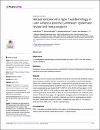Herpes simplex virus type 1 epidemiology in Latin America and the Caribbean: Systematic review and meta-analytics
Date
2019Metadata
Show full item recordAbstract
Objectives To investigate the epidemiology of herpes simplex virus type 1 (HSV-1) in Latin America and the Caribbean. Methods Systematic review and meta-analytics guided by the Cochrane Collaboration Handbook and reported following the PRISMA guidelines. Results Thirty-three relevant reports were identified including 35 overall (and 95 stratified) seroprevalence measures, and five and nine proportions of virus isolation in genital ulcer disease (GUD) and in genital herpes, respectively. Pooled mean seroprevalence was 57.2% (95% CI: 49.7-64.6%) among children and 88.4% (95% CI: 85.2-91.2%) among adults. Pooled mean seroprevalence was lowest at 49.7% (95% CI: 42.8-56.6%) in those aged ?10, followed by 77.8% (95% CI: 67.9-84.8%) in those aged 10-20, 82.8% (95% CI: 73.1-90.8%) in those aged 20-30, 92.5% (95% CI: 89.4-95.1%) in those aged 30-40, and 94.2% (95% CI: 92.7-95.5%) in those aged ?40. Age was the strongest source of heterogeneity in seroprevalence, explaining 54% of variation. Evidence was found for seroprevalence decline over time. Pooled mean proportion of HSV-1 isolation was 0.9% (95% CI: 0.0-3.6%) in GUD and 10.9% (95% CI: 4.4-19.4%) in genital herpes. Conclusions HSV-1 is a widely prevalent infection in this region, but its epidemiology may be slowly transitioning, with still limited contribution for HSV-1 in genital herpes.
Collections
- Public Health [462 items ]


